We have reached the most important. We have a trading program. So, first of all, it should contain a list of the names of the goods that we plan to sell. In the user menu go to "Product Names" .
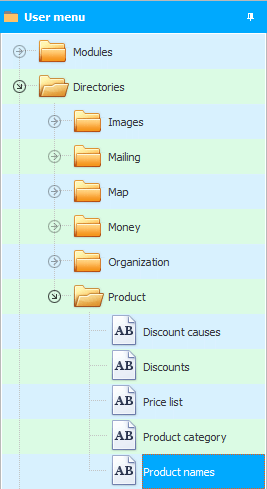
Products initially appear in a grouped form for a compact presentation, since there can be a lot of them.
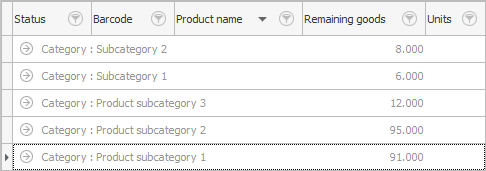
![]()
![]() Expand all groups with the help of this article so that we can see the names of the products themselves.
Expand all groups with the help of this article so that we can see the names of the products themselves.
The result should look like this.
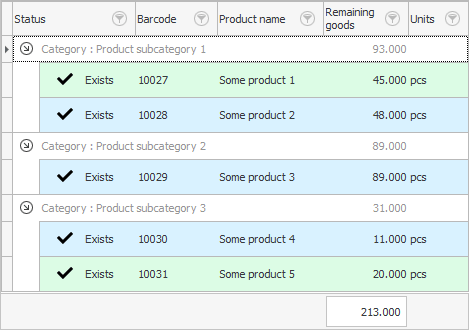
First column "Status" is not filled in by the user, it is calculated by the program and shows whether the product is in stock.
Next column "Barcode" , which is completely optional. ' Universal Accounting System ' is very flexible, so it allows you to work in different modes: if you want, sell by barcode, if you want - without it.
If you decide to sell by barcode, you will also have a choice: you can enter the factory barcode of the product you are selling here, or the program will assign a free barcode itself. This will be required if there is no factory barcode or if you manufacture this product yourself. That is why in the picture the goods have barcodes of different lengths.
![]() If you plan to work with barcodes, see supported hardware .
If you plan to work with barcodes, see supported hardware .
![]() Learn how to find a product with a barcode scanner .
Learn how to find a product with a barcode scanner .
As "Product name" it is desirable to write the most complete description, for example, ' Such-and-such a product, color, manufacturer, model, size, etc. '. This will help you a lot in your future work, when you need to find all the products of a certain size, color, manufacturer, etc. And it will definitely be required, to be sure.
![]() The product can be found by quickly moving to the desired one.
The product can be found by quickly moving to the desired one.
![]() You can also use
You can also use ![]() filtering to display only the product that meets certain criteria.
filtering to display only the product that meets certain criteria.
"Remaining goods" is also calculated by the program depending on "receipts" And "sales" , which we will get to later.
![]() See how the program displays the number of entries and the amount .
See how the program displays the number of entries and the amount .
"Units" - this is what you will calculate each item in. Some goods will be measured in pieces , some in meters , another in kilograms , etc.
![]() See how to sell the same product in different units of measure . For example, you sell fabric. But it will not always be bought in bulk in rolls. There will also be retail sales in meters. The same applies to goods that are sold both in packages and individually.
See how to sell the same product in different units of measure . For example, you sell fabric. But it will not always be bought in bulk in rolls. There will also be retail sales in meters. The same applies to goods that are sold both in packages and individually.
These were the columns that are visible initially. Let's open any product to edit to see other fields, which, if necessary, you can always ![]() display .
display .
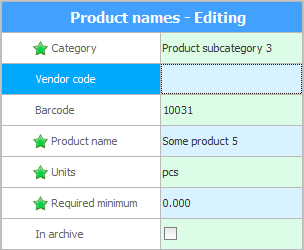
Optional field "vendor code" is intended to store some additional identifier besides the barcode. For example, it may be some internal product number from the manufacturer.
Field "Required minimum" allows you to set a minimum balance for a hot item. If the balance becomes less, then the program will instantly notify the responsible employee specified in the program settings via pop-up notifications.
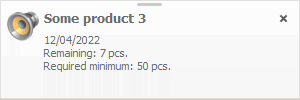
![]() Look about pop-up notifications .
Look about pop-up notifications .
check mark "Archived" can be delivered if you are completely sold out and no longer plan to work with some product.
At the end of editing, click the button "Save" .
In the product nomenclature reference book, as in any other table, there is "ID field" .
![]() Read more about the ID field .
Read more about the ID field .
![]() If you have a product list in Excel format, you can
If you have a product list in Excel format, you can ![]() import .
import .
![]() And for clarity, you can add an image of the product .
And for clarity, you can add an image of the product .
![]() Or go straight to posting the goods .
Or go straight to posting the goods .
![]() The program allows you to easily analyze the goods sold .
The program allows you to easily analyze the goods sold .
![]() Later, you can easily determine which product is not for sale .
Later, you can easily determine which product is not for sale .
![]() Find out which product is the most popular .
Find out which product is the most popular .
![]() And the product may not be very popular, but the most profitable .
And the product may not be very popular, but the most profitable .
See below for other helpful topics:
![]()
Universal Accounting System
2010 - 2024